The post Countdown to Bangkok appeared first on The Source.
]]>With huge investments being directed towards water and sanitation infrastructure, particularly in the Global South, IWA’s Water and Development Congress & Exhibition (WDCE) 2025 will once again deliver a comprehensive programme focused on the water-related needs of low- and middle-income countries.
To be held in Queen Sirikit National Convention Center, Bangkok, Thailand, on 8-12 December 2025, this edition will build on the success of the 2023 edition held in Kigali, Rwanda, providing the vital opportunity to share knowledge on innovations in science and practice, and highlight the opportunities for securing new and effective solutions in water and sanitation policy, technology and management.

Reflecting on the challenges of the region, the Governor of Thailand’s Metropolitan Waterworks Authority (MWA), one of WDCE’s partner organisations, Suwara Thawitchasri said: “One of the most critical challenges we face is the security and quality of raw water sources. Climate change is creating increasingly unpredictable conditions – droughts, floods, and saltwater intrusion – that directly affect both the availability and quality of water for production.
“Another key issue is the growing demand for water driven by rapid urbanisation. As Bangkok continues to expand, we must consistently upgrade and expand our supply networks to ensure safe and reliable access to clean water for every community. These issues are vital because they directly impact public health, the resilience of the city, and the overall economic development of Thailand.”
Advancing innovation
With an overarching theme of ‘Water, sanitation, and innovation – pathways to progress and a resilient future’, this year’s WDCE will present solutions spanning water and sanitation services, the role of water in urban areas, the links between cities and basins, and the opportunities to achieve climate resilience. Featuring keynote addresses by leading figures in the sector, specially invited to share their experiences in shaping and delivering solutions, the programme will also provide a unique platform for water professionals to present and share their recent findings and insights.
High Level Summit
A landmark feature of WDCE 2025 will be the High Level Summit on ‘Water Security and Resilience’ to be held on 9 December. Convened in collaboration with the Asian Institute of Technology (AIT), the Asian Development Bank (ADB), and other strategic partners, this prestigious event aims to bring together the political and decision-making aspects of water and sanitation, complementing the technical and professional dialogues with strategic leadership perspectives, creating an unparalleled opportunity to align regional and global priorities on water security.
This invitation-only event will gather high-level leaders from governments, international organisations, and key institutions across South and Southeast Asia, ensuring a trusted space for regional voices to come together. The discussions will culminate in the release of the Bangkok Communiqué on Water Security and Resilience, a forward-looking statement reflecting shared priorities and actionable pathways toward a more secure and resilient water future.
Asari Daud, IWA Vice President, said: “The pressures on our water systems are intensifying, and the urgency of advancing water security and resilience has never been greater. In South and Southeast Asia, where rapid growth meets climate stress, the challenges are profound but so too are the opportunities. This summit provides a vital platform to unite regional leaders, breaking down silos, and building new models of cooperation. By aligning political will with technical expertise, and fostering South-South collaboration, we can accelerate progress toward the Sustainable Development Goals and shape a shared, resilient water future. The Bangkok Communiqué will stand as a statement of our common priorities and a roadmap for collective action.”
Utility and Regulation Forums
‘Driving innovation, shaping inclusive and sustainable water futures’ is the theme of the Utility Leaders Forum, which will be held on 10 December. Presenting a unique opportunity for those tasked with managing utilities to exchange views, network and access the insights of prominent water utility leaders in a setting that is by utility leaders for utility leaders, the Utility Leaders Forum is curated by an international committee of experienced utility practitioners and is structured to facilitate an open and interactive dialogue around some of the most critical issues facing utilities.
William Fernandes, deputy general manager, City of Toronto, and IWA Board member said: “In IWA we aim to be a global home for utilities, engaging them in enriching exchanges. We see utilities standing at the intersection of innovation and responsibility. This iteration of the Utility Leaders Forum is a unique opportunity to share global perspectives and learn from each other’s successes and failures in innovation. We hope that this forum will bring about meaningful change, ensuring water services are inclusive, sustainable and resilient for all communities.”
Also taking place on 10 December is the International Water Regulators Forum, this year marking its 10th anniversary and offering a unique opportunity to explore regulatory innovation, regional cooperation and inclusive governance.
Emerging Water Leaders Forum
The 2025 Emerging Water Leaders Forum, which will be held on 11 December, will focus on equipping the next generation to lead in the face of climate, governance, and capacity challenges, ensuring water systems are resilient, equitable, and future-ready. Strongly aligned with the resilience focus of this edition of WDCE, the forum will have an emphasis on personal and institutional growth, showcasing future-ready skills, inclusive leadership and big picture strategic thinking.
Chotiwat Jantarakasem, Chair of Thailand’s Young Water Professionals Chapter, said: “Every day, Young Water Professionals are driving change across the global water sector. This year, I’m thrilled to welcome young people to my home country. The IWA Emerging Water Leaders Forum will not only recognise the vital role of youth in the water sector, but also inspire us to imagine what we can achieve together for a better water future.”
Inclusive Urban Sanitation Forum
Also taking place on 11 December, the Inclusive Urban Sanitation (IUS) Forum will provide a platform to share lessons from three years of engagement in advancing the Citywide Inclusive Sanitation (CWIS) approach, highlighting key findings from the recently completed CWIS Global Consultation, which gathered insights from more than 50 organisations worldwide. It will also serve as an opportunity for sector stakeholders to reflect on progress toward the Sustainable Development Goals in relation to sanitation and explore priorities beyond 2030.
Priscillah Oluoch, head of sanitation and programmes at the Malindi Water and Sewerage Company, Kenya, and a member of the IUS Task Force said: “Inclusive urban sanitation is about more than infrastructure, it is about people, power and possibility. Progress happens when every voice counts, when communities help shape solutions and when institutions break silos to work together. Citywide Inclusive Sanitation shows us that resilience grows when sewered and non-sewered systems coexist, when innovation is guided by equity, and when dignity and health are at the centre of design. In a changing climate and with fast-growing cities, the most powerful innovation is inclusion, because only by serving everyone, everywhere, can sanitation become the true foundation of sustainable and resilient futures.”
From Land to Sea
A further forum to be held on 11 December is ‘From Land to Sea: Tackling Pollutants, Protecting Health, and Restoring Ecosystems’. This forum will explore the sources of pollutants from land and sea, their impacts on human health and marine ecosystems, and identify practical solutions to reduce these threats and promote healthier, more resilient environments.
Advancing solutions for the region and beyond
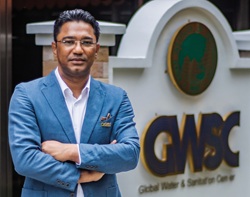
“Climate change, urbanisation, and population growth are intensifying water challenges across Asia,” said Prof Sangam Shrestha, co-director of the Global Water & Sanitation Center at the Asian Institute of Technology, Thailand. “We believe integrated solutions – digital innovations, nature-based approaches, and inclusive governance – are critical for resilience and equitable access. The IWA Water and Development Congress & Exhibition 2025 is a vital platform to exchange knowledge, showcase regional leadership, and build global partnerships that advance water security and accelerate progress towards SDG 6.”
Local relevance is highlighted by Wilas Chaloeysat, Governor of Thailand’s Metropolitan
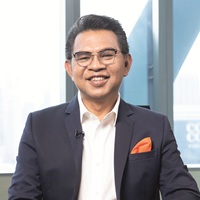
Electricity Authority (MEA), a partner organisation of WDCE, who said: “For the Metropolitan Electricity Authority, efficient water management is a priority issue directly linked to both society and the environment. We place strong emphasis on responsible water use, minimising the impacts of wastewater and ensuring long-term water security. For MEA, comprehensive management is not only about meeting operational needs, but also about aligning with environmental standards and our commitment to social responsibility.”
Looking internationally, Dr Jennifer Balatedi Molwantwa, CEO of the Water Research

Commission (WRC), South Africa, a strategic partner of the WDCE, said: “Research, development, and innovation extend beyond local challenges. The WRC values collaboration at regional, continental, and global levels to exchange insights, share lessons and co-create scalable solutions for the water and sanitation sector. As a strategic partner, WRC is pleased to see sanitation featuring prominently on the development conference agenda. Addressing water and sanitation challenges remains central to achieving inclusive and sustainable development. The WRC looks forward to a successful Development Conference and the meaningful exchanges it will foster.”
With inspiring keynotes, forums, social activities and an extensive exhibition, this edition of IWA’s Water and Development Congress & Exhibition is set to deliver a world-class event dedicated to delivery of sustainable water and sanitation to those in pressing need.
As Prof Pai-Chi Li, President of co-organiser AIT, concluded: “We are proud that AIT is co-hosting the International Water Association’s Water and Development Congress, which reflects our role as a hub for innovation, dialogue and collaboration in Asia. Our vision is to build a sustainable and inclusive future, and this gathering presents an opportunity to connect global expertise with local action, transforming ideas into tangible solutions that enhance water and sanitation for communities across Southeast Asia and beyond.”
More information
www.waterdevelopmentcongress.org
ADB and water – a strategic imperative for Asia and the Pacific
Norio Saito, Senior Director, Water and Urban Development Sector Office, ADB
Asia and the Pacific are facing a convergence of threats: growing demand, resource scarcity, climate extremes, and growing inequality. In this context, water security isn’t just a development goal, it’s a strategic imperative for resilient, sustainable, and inclusive growth.
The Asian Development Bank’s (ADB) forthcoming publication, Asian Water Development Outlook (AWDO) 2025, will show that Asia-Pacific is making strides in water security. However, the stakes are rising. Our data finds that over the past 12 years, a significant number of people have moved out of extreme water insecurity, thanks to countries prioritising their weakest areas, mainly in rural water supply and sanitation services. Yet, despite having basic access to water supply and sanitation, many remain vulnerable to poor water quality, unsafe sanitation, ecosystem degradation and climate shocks.
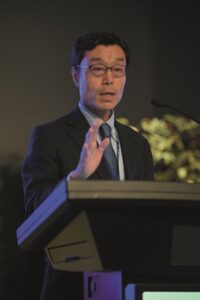
In addition, climate-related disasters are accelerating, outpacing readiness and reversing hard won development gains. Moreover, environmental water security has emerged as the region’s most urgent challenge, with ecosystems under siege from unchecked development and underinvestment in conservation efforts.
AWDO 2025 will make it clear that infrastructure alone is not enough. Without sustainable service delivery, maintenance, and healthy ecosystems, water systems cannot deliver lasting health or resilience. The path forward demands bold, integrated action where climate adaptation, ecosystem protection, and inclusive planning are no longer optional, but essential.
In response, ADB is scaling up efforts for water security through financing, technical assistance, knowledge, and partnerships. Non-revenue water reduction is critical to reduce wastage and improve service delivery inclusively and efficiently. We are helping our client countries strengthen water sector policies, institutions, and regulations to enhance sustainability and attract the private sector. City-Wide Inclusive Sanitation (CWIS) is being mainstreamed to provide safely managed sanitation services inclusively. In addition, the Glaciers to Farms initiative – aimed at mobilising up to $3.5 billion from ADB and the Green Climate Fund – has been launched for glacier preservation and to enhance the resilience of communities, food systems, and social infrastructure in nine countries in Central and West Asia. We are also strengthening multilateral cooperation and governance to address systemic challenges.
As Principal Strategic Partners we hope that IWA’s Water and Development Congress & Exhibition 2025 (WDCE) will provide a vital platform for dialogue and innovation, enabling ADB to strengthen partnerships with governments, financiers, the private sector, academia, and other relevant organisations.
AWDO 2025 will be officially launched at the WDCE opening plenary session on 8 December. We look forward to meeting you at the event to exchange ideas and forge partnerships to build a water-secure and climate-resilient future.
The post Countdown to Bangkok appeared first on The Source.
]]>The post Inside IWA’s DNA: how we adapt and thrive appeared first on The Source.
]]>Fresh from another outstanding Congress, I was reflecting on just what it is that keeps IWA going from strength to strength. What is it that makes us special? For sure, it is all about our members. But what is it about the way we work, how we are set up – what is it in our DNA – that delivers success?
Like the water we steward, I see that our mission and members are never still, instead responding to demand in new ways and in new places. This mobility sets us apart and equips us for the future.
Ahead, it is clear that international water-focused organisations face challenges more pressing than ever. Many struggle to remain relevant, grappling with weak governance, financial instability, lack of diversity, and a failure to adapt to the changing needs of their members and constituencies – all areas in which IWA is strong. In this landscape, organisations may fail or lose credibility. At IWA, we are acutely aware that our success cannot be taken for granted. We must remain vigilant and proactive in responding to the complexities of today’s global environment. And the signs are positive, with IWA evolving and growing in stature as a bridge-builder, dismantling silos and opening pathways to connect and pull in broad stakeholders spanning dimensions such as finance, regulation, policy and decision-making.
Our Congresses – a platform empowering practical change
So, our evolution sees us thriving, and that thriving is evident in our relevance. We can see a microcosm of that relevance in our World Water Congress & Exhibition (WWCE) series, demonstrated vividly recently in Toronto.
At its core, the Congress is a member-led initiative, driven by the interests and expertise of our network. From the Programme Committee to workshops and member segment-led forums, we put members in the driving seat, shaping the fabric of the event. We do not charge fees for staging workshops, meaning their inclusion is based on merit, and many of the workshops are organised in partnership with leading organisations. This all means the Congress embodies our commitment to inclusivity and is responsive to sector needs. Furthermore, the high level of youth participation adds a vital dimension, ensuring fresh perspectives and emerging leaders are integral to the conversation.
The success of our Congresses extends beyond simply gathering experts. They embody IWA’s raison d’être, bridging science and practice and diffusing new ideas. By being a powerful interface between researchers and practitioners accelerating the adoption of new approaches and technologies, they act as catalysts for transformation in the water sector. We apply this to target critical challenges such as climate change, lack of sanitation, and emerging contaminants. In doing so, this platform fosters the readiness of the global water community to implement solutions and drive meaningful change.
Additionally, the Congress is powered by member segment-led agendas that tackle pressing issues through forums such as the Utility Leaders Forum, Industrial Water Forum, Groundwater Forum, and the International Water Regulators Forum. These promote meaningful discussions that influence the future of the water sector.
These forums in particular go beyond technology. They draw in utility leaders, regulators and others with a vital role in implementation, who shape the conditions that allow solutions to be taken up. So, by integrating technological readiness with organisational, social, and regulatory preparedness, our Congresses – as is the case also for our Water and Development Congresses in intervening years – position IWA such that we can convene, advance discussions, and lead in the shaping of policies and scalable, sustainable solutions.
“the Congress embodies our commitment to inclusivity and is responsive to sector needs”
More broadly, our open, pluralistic approach enables knowledge exchange in all directions, including South-South. Our Water and Development Congress in Kigali last December was a testament to this last point, with strong exchange between Africa and Asia. Furthermore, with our many Specialist Group events taking place all around the world, our wider events programme is not locked into a single regional orthodoxy.
It’s in our DNA
This restless approach, with constant motion, didn’t happen overnight, or by accident. It is rather the result of a unique genetic code through which we adapt to a fast-moving world.
Agility is part of this make-up. We know when to strategically move forward and adjust our focus, allowing for organic evolution within our structure. For example, in the past, alongside serving members, we pursued diverse project-based initiatives. Today we are focused on our central mission of serving member interests and our programmatic activity is tightly focused on our core strengths, ensuring we manage the present while also preparing for the future.
Financial sustainability is another cornerstone of IWA’s DNA. We practise financial prudence, living within our means without relying on external subsidies or government support. This model ensures long-term independence and allows us to focus on delivering value to our members.
But beyond these, there are a few key elements that are central to our ability to adapt, grow and, as a result, provide leadership in our sector.
Blueprint for our fluid future
The core of IWA’s success has always been our Strategic Plan. Our soon-to-be-announced 2025-2030 plan not only reflects today’s water sector realities, but also anticipates future trends, challenges, and opportunities.
This new plan was framed by the Board, endorsed by the Governing Assembly, and built through wide consultation with Governing Members, Specialist Groups, the Strategic Council, and Young Water Professionals. This approach highlights the inclusivity strand of our DNA at work, ensuring representation of the global water community by design: we are a demand-driven organisation where members take the lead, embodying a pluralistic governance model that prioritises diverse perspectives.
Powered by this commitment, the plan recognises how civilisation is already under unprecedented stress, in an age of shifting climate patterns, population growth, and rapid urbanisation that compound pressure on water systems. It positions IWA as a key player in a global movement that is about more than the water itself, but also the interlocking systems that support water governance and infrastructure.
Our Strategic Plan advances the need for action on climate change, both in terms of adaptation and resilience and of mitigation opportunities. At the same time, it has a strong focus on sanitation around the world – and IWA’s leadership opportunity in this area. And running right through our sector, the new plan advances our ambitions on digitalisation.
Empowered by this strategic outlook, all parts of IWA can advance options that are relevant to future needs. Thanks to the IWA model, they can draw on insights from all around the world, especially from the Global South, and address challenges of developing and developed regions, whether that be applying decentralised water systems, nature-based solutions, solutions that integrate circular economy principles, and so on. Our growing digital toolbox will be vital in helping transform water utilities to operate more efficiently. Together we can advance an IWA that is committed to scaling up innovations, with developing countries at the forefront of many of the most exciting changes.
Infusions of fresh blood empower our future
If our Strategic Plan is IWA’s blueprint, then our Young Water Professionals (YWPs) are the incoming generation who will be responsible for bringing it to life. We do more than welcome their questions, innovations, and ambition into IWA; we depend on it. Their infusion of energy is central to who we are and how we operate, ensuring IWA remains agile and forward thinking.
With their contribution supercharged by interaction through the IWA network with more established great minds, YWPs play key roles in shaping IWA’s programmes and global discussions. Their tech-savvy approach bridges traditional practices and the demands of the digital age. Beyond technology, YWPs bring a strong social conscience to water governance, advocating for inclusion and diversity. By pushing for climate justice, they ensure that vulnerable communities are not left behind.
Again, this inclusion of YWP voices from all around the world is by design, and the payback is that our agenda further reflects the widest possible range of concerns and perspectives.
Governance of, by and for members at every level
At the core of IWA’s nimble adaptability and resilience is our commitment to democratic governance. Undoubtedly one of our greatest strengths, our åmember-led, demand-driven structure ensures that water professionals from all regions and sectors are heard, and their needs addressed. Members can shape our direction, regardless of their geographic location or economic status. Such inclusive governance isn’t done for its own sake – it ensures IWA is more responsive and more relevant.
Indeed, from inception, IWA was created as a space for scientists, policymakers, and practitioners to collaborate across disciplines and geographies, representing a vision of knowledge exchange that is critical to solving global water challenges.
Drawing further on these experts from various disciplines, our Specialist Groups (SGs) exemplify this democratic governance in action. Whether it is advancing decentralised sanitation, promoting water reuse, exploring utilities’ roles in emissions reductions, sharing experiences of use of AI, and any number of emerging options, these groups act as incubators for new ideas and uptake of solutions. With such member-led activity raising the bar globally, we see how IWA’s distributed and modular network enables rapid, versatile and flexible responses to emerging issues. This adaptability is key to our success in a rapidly changing world.
“community-driven agendas will provide focus and direction”
And just as we have a diverse Secretariat, IWA’s Governing Members, coming from diverse geographies, further ensure our organisation reflects the full breadth of the global water community. The new Strategic Plan emphasises the key role of Governing Members as IWA’s representation in countries and regions, with this engagement to be strengthened under the plan.
So, as IWA looks forward to the future World Water Congresses in Glasgow, Kuching, and São Paulo through to 2030, and the Water and Development Congresses and Specialist Group events between them, we can be confident that community-driven agendas will provide focus and direction. This democratic input will power the programmes and advance the readiness agenda, especially through platforms such as the Utility Leaders Forum and the International Water Regulators Forum.
Digital tools for inclusive transformation
To improve the flow of such distilled and diverse ideas, IWA has also embraced digital platforms that enhance democratic engagement. IWA Connect Plus, our online membership portal, lets members collaborate in real time, and access and share resources. Deepening and broadening member engagement, it helps keep us at the forefront of shaping the water agenda.
With the world facing increasingly complex water challenges, our ability to digitise knowledge and share innovations has become more essential than ever. We have extended our reach by embracing Open Access, ensuring vital knowledge and learning resources are now available to all, everywhere, free of charge. Such democratisation of knowledge has levelled the playing field, especially for professionals in Least Developed Countries, who previously may have lacked access to such resources. We have also added huge value to IWA membership, with members able to access the vast water-specific resources in the Treasure Chest library in Connect Plus, plugging them into the insights from our flagship events and Specialist Group conferences, magazine articles, webinars and more. Removing barriers empowers a new generation of water professionals to take the lead in any region and sector of the world.
Still, digitalisation is only part of the IWA equation. Further transformation comes from ensuring that more voices are heard from traditionally underrepresented regions. Our efforts to diversify our membership among women, youth, and professionals from Africa, Asia, and Latin America helps us reflect a more equitable and representative – and thus better governed – water sector.
The ever-evolving current
IWA is, was, and will continue to evolve as a living, breathing organisation. Like water, we are in constant motion, adapting to the challenges and opportunities around us. Our success lies in our ability to balance tradition with innovation, stability with flexibility.
In a world where so many organisations are struggling to maintain relevance, we see others outside our immediate membership turning to IWA more than ever as a platform of choice, seeking to align themselves with our values and expertise. That said, while proud of where we’ve come from, we can never rest, never grow complacent. Rather, with each new handshake, each day, each new discovery, we become more excited about where we’re headed.
Yes, we are endowed with a built-in natural DNA of resilience. Yet nurture plays a decisive role. Our constant infusions of fresh blood, our commitment to inclusivity, and our member-driven democratic governance ensure we reflect a global water community in which all voices – from the Global North and Global South, young and old, and from all levels of development – are heard and valued. This ensures IWA remains dynamic, forward-looking, and ever-relevant, shaping a better-governed, more inclusive global water agenda. •
The author: Kala Vairavamoorthy is CEO of the International Water Association
The post Inside IWA’s DNA: how we adapt and thrive appeared first on The Source.
]]>The post IWA touches down in Toronto appeared first on The Source.
]]>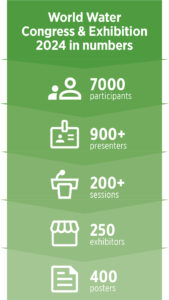 Drawn by a comprehensive programme and a global exhibition, the latest edition of IWA’s biennial flagship event brought together participants to present and access the latest insights on the world’s most pressing water-related issues, networking and making connections, and building partnerships to further change. Held in Toronto, Canada, on 11-15 August, the IWA World Water Congress & Exhibition 2024 was an outstanding event, hosting 7000 participants from around the world.
Drawn by a comprehensive programme and a global exhibition, the latest edition of IWA’s biennial flagship event brought together participants to present and access the latest insights on the world’s most pressing water-related issues, networking and making connections, and building partnerships to further change. Held in Toronto, Canada, on 11-15 August, the IWA World Water Congress & Exhibition 2024 was an outstanding event, hosting 7000 participants from around the world.
Under the banner of ‘Shaping our water future’ and featuring more than 900 presentations and 200 sessions, the event was of particular relevance to the climate change agenda and the UN Sustainable Development Goals (SDGs) – especially the need and opportunities for progress with sanitation. But including and beyond these two critical themes, the programme was notable for its richness and diversity, drawn from IWA’s membership and its strong network of respected water professionals. With content proposals hugely oversubscribed, the programme committee had a wealth of excellent content from which to select, and this was evident from the quality and breadth of the presentations and workshops.
Staged with the great support of CWWA, CAWQ and Destination Toronto, the Congress gathered water experts, thought-leaders, decision-makers, leading researchers, and business representatives from within and outside the water sector. It featured five dedicated forums: the Utility Leaders Forum; the International Water Regulators Forum; the Emerging Water Leaders Forum; and forums on groundwater, and industry and water.
Discussions were focused on six main – hugely topical – thematic tracks: water utility management; wastewater and resource recovery; drinking water and potable reuse; city-scale planning and operations; communities, communication and partnership; and water resources and large-scale water management.
Plenary keynotes and panel discussions
Alongside all of this, plenary sessions with keynote speakers and panel discussions brought to the fore key water challenges and thinking on how to respond to them, with one particular highlight being the keynote speech given at the Opening Ceremony by leading scientist, innovator and communicator Dr Peter Gleick.
The co-founder of the Pacific Institute in Oakland, California, based his keynote on his latest book, The Three Ages of Water: Prehistoric Past, Imperiled Present, and a Hope for the Future, in which he sets current concerns around water in context, but looks also to examples providing options for the future. His message to delegates was that we have the skills for success – an empowering message that set the tone for Congress at this critical time for action.
“Dr Gleick’s message to delegates was that we have the skills for success – an empowering message that set the tone for Congress at this critical time for action”
The impressive keynote speaker line-up through the week included Paul Brown, President, Paul Redvers Brown Inc., who focused on resilience in planning and project management. Ong Tze-Ch’in, Chief Executive, PUB, Singapore’s national water agency, spoke on the utility’s digital future under the title of ‘A Smart and AI-enabled PUB’. Professor Amy Pruden, Virginia Tech, USA, explored health concerns and connections with water under the topic of ‘The water sector and the slow pandemic of antimicrobial resistance’. Batsirai Majuru, Technical Officer, Water, Sanitation, Hygiene and Health Unit at the World Health Organization, highlighted the important role of regulation in securing basic needs with ‘Taps and toilets in the time of change: A new era for water and sanitation regulation’.
Saroj Kumar Jha, Global Director, Water Global Practice, World Bank Group, explored the increasingly important area of financing water solutions for climate resilience. In the same plenary session, Henk Ovink, Executive Director, Commissioner, Global Commission on the Economics of Water, USA, and the Netherlands’ first water envoy, gave a keynote on the economics of water, with particular focus on the impacts of climate change on the young and the most vulnerable. Farokh Kakar, Environmental Engineer, Brown and Caldwell Consultants, set out thoughts on youth, technology and water. Lastly, Professor Juliet Willetts, Institute for Sustainable Futures, University of Technology Sydney, Australia, brought several of the week’s themes together in her talk on ‘Path-shifting to address global challenges: Transformative adaptation in practice’.
The keynotes were complemented by some outstanding panel discussions. Convened by IWA, these featured participation of the leadership of key industry organisations from around the world, such as the Water Services Association of Australia, AWWA, ESAWAS, WEF, DANVA, Australian Water Association, and ABES.

Forward-looking utility agenda at its core
This participation reflected the wider prominence of utilities, regulation, and water and sanitation service provision as a core focus of the Congress.
This was particularly evident through the latest Utility Leaders Forum and the 9th International Water Regulators Forum. The former was organised over two days and proved again to be an excellent focus for utility participation in the Congress, attracting more than 250 utility professionals and bringing together prominent water utility leaders with impactful experiences to share. Sessions at the Utility Leaders Forum covered water security and resilience, and breakthroughs on climate adaptation, as well as utility work on the circular economy.
Utility activity was also at the heart of the opportunity the Congress gave to recognise practical attention to climate change. Under the IWA Climate Smart Utilities Initiative, the 2024 edition of the Recognition Programme, supported by Xylem, identified and recognised water and sanitation utilities for their efforts in tackling climate change with breakthrough technologies to address challenges such as water scarcity, climate adaptation and the circular economy. This year’s recognition was presented in two categories: the Achiever (utilities that have already made substantial progress in their climate smart journey) and Entrant (utilities that have prioritised the climate agenda and have started their climate smart journey).
Accessing industry expertise
One of the special aspects of Congress is the opportunity to meet other water sector professionals face to face and access up-to-date expertise. This includes connecting with sponsors who, this year, featured Grundfos and Xylem as Principal Sponsors, and the City of Toronto as Platinum Sponsor, as well as Jacobs, Ramboll, Black & Veatch, Noventa, Enwave, Comcore, Stantec and CSD Water Service. The exhibition show floor hosted 250 exhibitors from around the world. This saw staging of an Operations Challenge and featured an extensive Business Forum programme, all providing the perfect environment to catch up with existing contacts, forge new relationships, and find out about the latest state-of-the-art technologies from world-leading solutions providers, equipped to transform urban water management and, with that, our cities of the future.

Recognition of excellence
The Opening Ceremony had set the tone for the week, not least in terms of Toronto being a platform for excellence. Three prestigious awards were revealed in the Opening Ceremony: Professor Joan Rose was announced as the recipient of the Global Water Award; Sabrina Rashid Sheonty won IWA’s Young Leadership Award; and Professor Juliet Willetts won the Gender Diversity and Water Award.
The highest of IWA’s global accolades, the Global Water Award, recognises exceptional individuals who, through innovative leadership and practice, have made an outstanding contribution to progress towards a world in which water is wisely managed.
The 2024 winner, Professor Joan Rose, is a hugely respected member of the global water community and global leader on wastewater surveillance, the Homer Nowlin Chair in Water Research at Michigan State University, USA, and Co-Director of the university’s Center for Advancing Microbial Risk Assessment (CAMRA).
Her work on water reuse, pathogen removal, and climate and waterborne diseases, which focuses on the application of new molecular methods, surveillance of pathogens, removal of pathogens by water and wastewater treatment, and quantitative microbial risk assessment has contributed to international understanding of the impact of water quality on health. Her career has addressed the pressing problems of crypto-sporidium and protozoa, with her research producing leading, globally respected, academic papers on the subject.
This recognition of excellence ran from start to end, with the Closing Ceremony including the announcement of the six outstanding poster presentations from the 400 displayed, the recipients being: Embrey Bronstad, USA; Yujie Chen, Tohoku University, Japan; Xiaonan Tang, The George Washington University, USA; Polly Grundy, Cranfield University, UK; Faruque Mia, Regional Municipality of York, Canada; and David Renfrew, Imperial College London, UK.
Mobilising participation
Looking to the future of the water sector, participation of Young Water Professionals (YWPs) stood out prominently at the Congress. The first cohort of IWA LeaP, IWA’s leadership programme aimed at empowering young water professionals, was announced. This initiative focuses on equipping the next generation of leaders with the skills and knowledge needed to tackle pressing global challenges, such as climate change and water scarcity. Furthermore, the continuation of the IWA and Grundfos Youth Action for SDG 6 Fellowship Programme was confirmed. This was all in addition to staging the latest Emerging Water Leaders Forum.
Practical progress on water also depends on successful implementation of projects and the Congress again provided the opportunity to celebrate examples of success from around the world at the IWA Project Innovation Awards Gala.
An end with new beginnings
In keeping with tradition, the Congress Closing Ceremony saw the handing over of the IWA ‘talking stick’ to the next host of the event, also with the outgoing IWA President giving the stage to the new one. The latter saw Tom Mollenkopf AO handing the Presidential baton to Professor Hamanth Kasan. An IWA Distinguished Fellow, Professor Kasan’s extensive experience in the sector spans 34 years, marked by leadership roles across academia, utilities and international development agencies, and as an Honorary Professor at the Institute of Water and Wastewater Research he has advanced world-class training and research in African water services.
Attention now turns to the 2026 edition of the World Water Congress & Exhibition, which will take place in Glasgow, Scotland. Already excited to receive the next edition of this prestigious Congress, our 2026 hosts helped close the Toronto event with a stirring bagpipe performance, giving us a flavour of what we can look forward to when we convene again in two years’ time. •
More information
The post IWA touches down in Toronto appeared first on The Source.
]]>The post Digital transformation takes the global water sector by storm appeared first on The Source.
]]>Digital transformation and digital water are concepts that have been present in the water industry for many years – yet it is fair to say that their adoption has been somewhat mixed. Depending on where you are in the world, the industry has many and varied challenges, but underpinning all of this is Sustainable Development Goal (SDG) 6, the need to “ensure availability and sustainable management of water and sanitation for all”. The progress on the goal has been slow at best. In 2021, the UN reported that “the world – on average – must quadruple current rates of progress to have a chance to achieve SDG 6 by 2030”.
When we look at digital transformation, there has been some confusion about what it actually means. For me, at least, it is a collection of digital tools that we – as a global industry – can use to inform us of our performance and what needs to be done, be this in addressing greenhouse gas emissions (GHGs), reducing energy intensive processes through operational and asset management efficiencies, or limiting the polluting impact that the water industry can have.
In this article, I look at three examples of where digital transformation has been used:
- To help reduce the impact on people from heavy storms caused by climate change in Brazil, using LoRaWAN.
- Using a wastewater collection network digital twin to increase efficiency and reduce pollution incidence in China.
- Using advanced asset management laser-scanning technology in the UK to increase the efficiency of design and operational management.
Managing climate change resilience in Brazil

The first case study shows how digital transformation can be used to increase urban resilience.
The IPCC Sixth Assessment Report (AR6) projects a 1.5-fold increase in heavy storms across the globe, even under scenarios of a more conservative rise in temperatures. This increase in heavy storms is already being experienced, with flood events occurring in many different countries, including Pakistan, Brazil and Germany.
“digital tools can help increase the urban resilience cycle”
Given that 55% of the world’s population lives in urban environments (UN DESA, 2019), there is an urgent need to strengthen the urban resilience of water, sanitation and stormwater drainage infrastructure. The use of digital tools can help increase the urban resilience cycle through the three steps of response: rehabilitation, mitigation and preparedness.
One example of this is the use of a telemetric hydrological monitoring system using a Long Range Wide Area Network (LoRaWAN) developed by the company Asthon Tecnologia, to monitor, predict and send alerts of extreme hydrological events in the urban area of Itajuba, a medium-sized city located in Brazil.
The Sapucai River is the main watercourse that crosses the urban area of the city and has a long history of major floods. In recent years, flash floods of tributary streams of the Sapucai River – within the urban area – have become more frequent. Intense, short-term rains cause riverbanks to overflow and streets to flood in several neighbourhoods. The mountainous and complex terrain requires a high density of monitoring stations, so that the full spatial variability of rainfall is captured. Furthermore, the response time of the basins is short, requiring telemetry measurements at very short intervals.
As Itajuba is a medium-sized city, monetary resources are limited, so the development of the telemetric system with LoRaWAN was chosen as a low-cost solution. This consists of a digital circuit board, which is extremely compact, with low energy consumption, requiring a small battery with a charge that can last for months without needing a solar panel for recharging. The sensors used are nationally manufactured and low cost.
The entire development of the system is based on several years of cooperation between team members and municipal civil defence teams. Their experience made it possible to identify the municipality’s requirements in relation to the occurrence of extreme hydrological events. During the operation of the system and the collection of hydrological data, an ANN Application for Water Quality Forecasting is being trained to help increase accuracy in predictions.
Wastewater network digital twins in China
This second case study looks at the rapid development of a wastewater network digital twin, which was created to allow a low maintenance approach with comprehensive monitoring to enable facilitated operational management.

The project was delivered in the People’s Republic of China, in Jiujiang, an underdeveloped area along the Yangtze River in Jiangxi Province. The area faced numerous challenges in the management of its wastewater collection network, which meant there was an absence of effective measures for managing urban flooding and overflow pollution, and a limited capability for the management of risk and proactive control.The project brought together data from multiple sources – including operations, workforce, water assets and instruments, work processes, monitoring data, and numerical models – to form a high-quality data platform and a smart monitoring system.
The development of the digital twin approach enabled the concept of the Urban Smart Water Steward in China to promote the integrated management of urban water and the environment, embracing water resources, raw water transportation, water treatment and distribution, wastewater collection and treatment, the drainage network, sludge treatment, and open water.
Leveraging GIS, dynamic monitoring, numerical simulation and big data enhances smart water applications, and fosters cross-departmental collaboration and efficient sharing of information.
The concept established a centralised, remote-control system that enables smart decision-making and dispatch planning. This approach reduced the likelihood of urban flooding and combined sewer overflows, enhanced the drainage system’s ability to respond to emergencies, and increased public satisfaction.
The platform serves an area of 80 km2 in the urban area of Jiujiang, encompassing four wastewater treatment plants, 1929 km of drainage pipe networks, more than 70 pumping stations, three regulating reservoirs, and associated pipe, river and lake facilities, providing for a population of 2.51 million.
Since it launched, a total of 316 user accounts have been activated, with the accumulated amount of monitoring data exceeding a billion. Daily water operation and management data has exceeded more than 49,600 entries.
In addition, model prediction data that assists in operational decision-making has exceeded approximately 10 million entries. The project has resulted in more than 10 patents and more than 40 software copyrights.
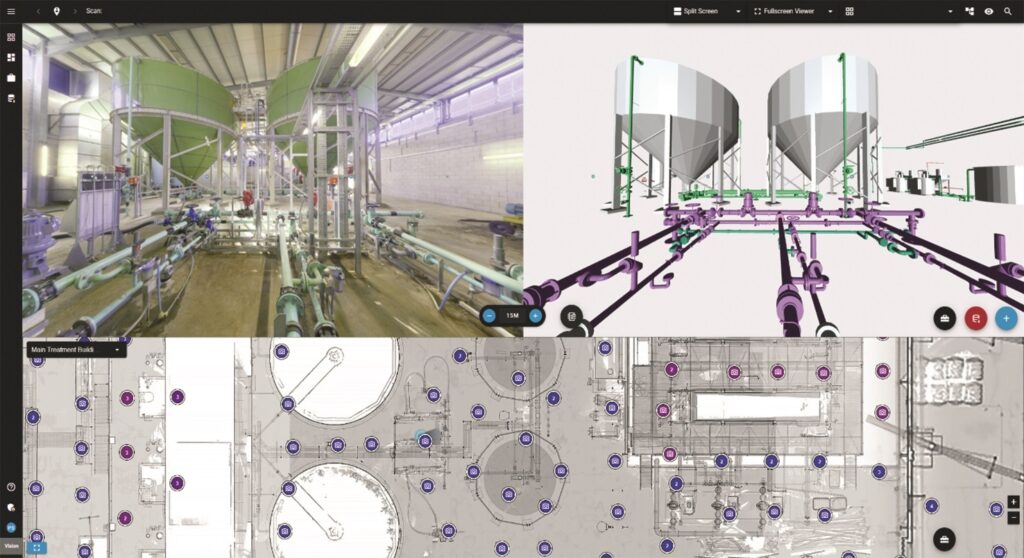
The project’s achievements include:
- 38% improvement in operational and maintenance efficiency;
- 26% improvement in energy efficiency;
- 60% reduction in maintenance failure rates;
- 80% of process operations and safety training being based on the digital twin application technology;
- in-depth data mining and analysis that has enabled six successful cases for pollution source tracing and source pollution control;
- an educational resource for future generations of water engineers, attracting more than 100 visits each year from a variety of stakeholders.
Increasing asset management efficiency in the UK
This case study looks at the application of Building Information Modelling (BIM) technology to provide effective asset management and design in both potable and wastewater management in the UK.
The water industry is a complex asset management industry, which, because of its size, is constantly transforming, with an extension of assets because of population growth, climate change, and increasing environmental needs. Engineering design has gone from draughtsmen working on paper to various increasingly complex methods for capturing information around the industry’s assets.
“accuracies of surveying are now down to the millimetre”
Twenty years ago, paper manuals would have been used to capture how all of these assets were working as a system. Modern ways of working instead use laser-scanning and capture assets in a point cloud. The technology has developed to the extent that accuracies of surveying are now down to the millimetre.
Digital tools enable a large degree of remote working, reducing the need for engineers to go onsite when working on designs, cutting down on travel and its associated carbon emissions. This also enables more efficient design to take place, with digital technology able to record assets in locations that are difficult to access and scanning to detect failing assets, enabling proactive maintenance.
In this case study, digitalisation allowed the operator to rapidly ascertain the as-built status of the site without operational disruption, resulting in updates to key information, such as documents and drawings. Digitalisation of this asset improved understanding of the client’s equipment inventory, aiding operational teams with easily accessible data that helps in preparation for site scopes. The visual condition assessment, conducted through a programme called Vision, identified unknown issues and prompted remedial actions.
The future
Digital tools are increasingly being used to help the water industry operate in a more efficient way across the globe, increasing operational and asset management efficiency, serving the public in a more enhanced way, and, ultimately, protecting the environment more sustainably. Digital tools have a huge potential to benefit the sector – and this is just the beginning. •
More information
IWA’s Digital Water Summit will take place on 12-14 November in Bilbao, Spain. To find out more, visit digitalwatersummit.org
The author: Oliver Grievson is an Associate Director at the global engineering consultancy AtkinsRéalis and a Royal Academy of Engineering Visiting Professor of Digital Water at the University of Exeter. He is also Chair of IWA’s Digital Water Programme
The author is grateful for the case studies provided by Marina Batalini de Macedo, of the Universidade de Itajubá, Brazil; Yufeng Guo, of Three Gorges Smart Water Technology, China; and Gareth McIntyre, of GDi, UK.
The post Digital transformation takes the global water sector by storm appeared first on The Source.
]]>The post Singapore’s route to an AI-enabled future appeared first on The Source.
]]>“PUB has come a long way in our journey to ensure clean, safe and sustainable water for Singapore,” said Ong Tze-Ch’in, the new Chief Executive of the country’s national water agency, in his keynote at the World Water Congress & Exhibition in Toronto, Canada, in August. However, there are challenges ahead – specifically with the utility’s remit spanning water supply, reclamation of used water, and protection from storm and coastal flooding. Key challenges include climate change causing increased risk of extended dry periods, more frequent and intense storms, and rising sea levels. In addition, water demand is expected to double by 2065.
Embracing digitalisation
“For us, technology has been, and will continue to be, the key avenue for PUB to address these strategic challenges. We see the opportunity brought about by digitalisation and AI, and its potential for automating PUB’s operational processes, improving productivity, enhancing situational awareness, and strengthening decision-making.”
PUB is already on this journey, having set out its Smart PUB Roadmap in 2018. “It outlines the systematic development of digital solutions and smart technologies, and the deployment of these across our water loop and business units,” said Ong. “When we first started, we focused on identifying and implementing digital technologies. We soon realised that this was not the best approach. We needed more than just technology alone. We had to look at transforming our business processes from end to end.”
Here he pointed to PUB’s IWMS – its intelligent water management system. “It’s our enterprise command control and communication system,” he explained. “It supports our central operations and incident management by integrating and analysing data from multiple sources. It provides us with real time situational awareness across the water loop.”
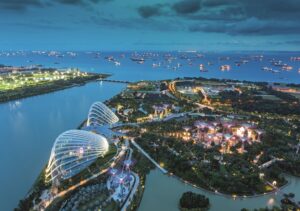
garden and Marina Barrage © iStock.com / Kanuman
Implementation of the IWMS involved customising PUB’s IT system and adjusting the organisation’s operational processes to make the most of efficiencies and opportunities. Aided by machine learning, PUB can predict water demand using historic consumption patterns for weekdays and weekends, and based on the weather. “This helps to guide our operational planning by matching our water production with our forecast demand,” said Ong.
He noted the importance of having adequate and good quality data. This is captured by a large number of sensors and CCTV cameras, providing the data for PUB to build digital twins and simulation models for its drainage, sewerage and water networks.
“Layering on data analytics and machine learning capabilities has provided useful insights for us,” said Ong. “We can now respond more quickly to issues such as water leakages, sewer chokes and floods. By reviewing the root causes of our operational issues, we can simulate future scenarios and test out plans, and this allows us to better optimise our resources and reduce costs.”
Ambitions for a smart and AI-enabled PUB
PUB is well down the road with this roadmap, but Ong has ambitions to escalate this progress. “As PUB’s new Chief Executive, I have decided that I want to double down on our digitalisation efforts and move towards a smart and AI-enabled PUB. We will continue to identify common business functions across departments and explore opportunities for new enterprise digital solutions.”
With more than 5000 CCTV cameras already in place across the organisation, one example that PUB is working on is a video masterplan. These cameras monitor operations, security and activities at PUB’s plants, installations and water bodies. “Imagine the value we can unlock if all these video feeds and alerts can be consolidated. And this is what our new centralised video management system does. It’s a single source of truth of video data across PUB.”
“PUB is a key climate adaptation agency for Singapore”
Ong explained that it is also a one stop application for incident management. “This reduces the time and effort that we need to identify a major incident and facilitates the sharing of information for decision-making,” he said. “With this single source of truth, the opportunity to layer on video analytics offers us great possibilities. We will now be better positioned to conduct operations centrally from our operations centre, with eyes looking across the entire water loop. You can just imagine the view that this will afford us when the system is fully operational.”
There is huge interest in the progress of generative AI, he said. “From PUB’s perspective, we see AI as transformative and game-changing, but we are taking it cautiously.” This has resulted in a focus on machine learning and deep learning.
“One clear area where PUB intends to move into AI in a big way is maintenance,” said Ong. Many assets are currently under a preventive maintenance regime. This is based on historical averages of failure rates and typically includes a built-in buffer. “This means that we’re likely to service or replace an asset too early. This is inefficient and adds cost. Our goal is to move towards a performance based predictive maintenance regime, one that uses analytics and high frequency data to predict the reliability of equipment.
“At our plants, we have started to implement condition monitoring for critical reservoir feed pumps. Upon early signs of anomalies, our maintenance crew will be alerted to take action before pumps fail. We are taking this further by developing machine learning modules to establish baseline performance of our assets. And, from there, we intend to use these models to predict the risk of failure. This will help us to optimise how we maintain and replace our asset base, which will continue to expand as our water demand grows.”
Another application area is in the use of drones and video analytics. First joking that this is used to target illegal fishing, Ong explained that the drones are used primarily for reservoir management. “We use it to check on aquatic plant growth in our reservoirs. We also use it to count vessels in the reservoirs. This technology has helped us to fulfil tasks that our scarce manpower simply cannot take on.”
The other area he highlighted was in relation to climate change. “With its mission to address coastal and flood resilience, PUB is a key climate adaptation agency for Singapore, and data and AI presents a huge opportunity for us to overcome our climate change challenges.”
A rainfall monitoring and prediction system has been in place since 2018, providing early rainfall warnings and indicating where flash floods could potentially happen. “We are now exploring machine learning models to forecast near-term drainage levels using data from radars, water level sensors and rain gauges. Today, we can monitor our reservoir and drainage operations in real time at our joint operations centre by bringing together the rainfall maps, CCTV cameras, and water level sensors. We have a system that can predict locations where heavy rain is expected and deploy our quick response teams early to flooding sites.”
“In reaching for the stars, one might just reach the moon”
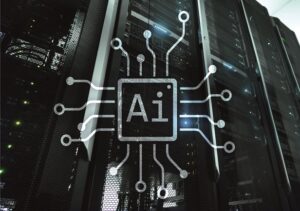
A coming step is the development of an integrated coastal inland flood model – the next milestone for PUB. “We are building a model that can simulate coastal and inland flooding,” Ong said. “This provides us with a combined flood risk assessment of Singapore’s low-lying areas and supports planning for long-term coastal protection measures.” He also mentioned plans for a new function to forecast storm surges. “We hope to enhance the model, to enhance our flood operations capabilities and emergency response planning under extreme coastal conditions.”
The people dimension
These plans for a smart and AI-enabled PUB have a human dimension, too. “To succeed in this journey, we need our people to come along,” he said. “We need to reskill and upskill our workforce.”
Ong previously worked on SkillsFuture Singapore, which he describes as Singapore’s lifelong learning movement. “We are trying to do the same thing,” he explained. “We are working very hard on what I call SkillsFuture at PUB.
“As new technologies are deployed, as business processes are changed, we need our staff to be able to keep up and to exploit these changes,” he said. With this in mind, PUB has put in place training courses to raise digital and AI competencies, as well as broader activity to give staff opportunities to learn new skills and build new networks.
There is another line of action alongside this, which he described as the hardest of all. “We are working to shift our people’s mindsets – for them to embrace the spirit of lifelong learning, to have the intellectual curiosity to pick up new skills and new knowledge, work in new environments and embrace new teammates.”
He made clear that digitalisation offers huge potential, especially with the advent of AI, and that this is needed given the prospects of climate change, increased water demand, and workforce challenges. “In reaching for the stars, one might just reach the moon. For PUB, we simply have to give this moonshot a chance – it’s the only way we can meet our triple challenges.” •
The post Singapore’s route to an AI-enabled future appeared first on The Source.
]]>The post Rising to the challenge of Citywide Inclusive Sanitation appeared first on The Source.
]]>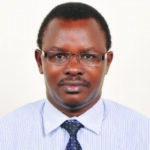 Charles B. Niwagaba, Associate Professor, Civil Engineering, Makerere University, Uganda
Charles B. Niwagaba, Associate Professor, Civil Engineering, Makerere University, Uganda
Capacity building to improve efforts to achieve Citywide Inclusive Sanitation (CWIS) should be developed based on a comprehensive needs assessment, and the selection of the right mix of people for training is essential. Training needs to target high-, mid- and low-level managers and staff. Without this range of experience and skills, the information flow chain will be broken.
Unfortunately, high-level staff often don’t have time to attend local training workshops and instead send less experienced members of staff. To improve capacity, we need training opportunities to catch all categories of employees. It is also important that the content of capacity development training is appealing, hands-on, and reflects the reality of the task to avoid trainees losing interest.
Capacity building of high- to low-level managers is not enough to realise meaningful sanitation improvements at community level. Capacity building needs to also include behaviour change and provide managers with the tools to promote behaviour change campaigns in the community. Such campaigns require a carrot and stick approach, and genuine enforcement is necessary.
Capacity building for non-technical key stakeholders, such as politicians, Mayors, councillors or other elected leaders should also be undertaken. Where possible, capacity training in the community would also be beneficial.
The Kampala Wejonje campaign is a good example. The Kampala Capital City Authority, Uganda, worked very hard with stakeholders to support and build capacity to improve sanitation. The challenge, however, is that the project is funded externally, and it is not clear if the current momentum can be maintained.
 Priscillah Oluoch, Head of Sanitation for Malindi Water and Sanitation Company (MAWASCO), Kenya
Priscillah Oluoch, Head of Sanitation for Malindi Water and Sanitation Company (MAWASCO), Kenya
For a utility like ours, or similar utilities aiming to incorporate and institutionalise the Citywide Inclusive Sanitation framework, there are several key challenges in building the necessary capacity. The CWIS framework prioritises safe, equitable, and sustainable sanitation for all, emphasising that service provision must adapt to the entire city, including all its residents, with special attention to underserved and vulnerable communities. Addressing these challenges requires a concerted effort that is adaptive and innovative.
Securing adequate funding is often the primary barrier to enhancing sanitation infrastructure. Investments are needed not only for initial capital outlay, but also for ongoing operation and maintenance. Utilities must explore diverse funding sources, including government budgetary allocations, international aid, private investments, and possibly sanitation tariffs/levies that reflect the true cost of services while ensuring affordability.
Institutionalising CWIS requires supportive policies and regulations that encourage inclusive and sustainable sanitation solutions. This involves updating or creating regulations that facilitate non-sewered sanitation solutions, faecal sludge management, and resource recovery options. Engaging with policymakers to ensure that the legal and regulatory environment supports innovative and inclusive sanitation solutions is critical.
Developing and maintaining CWIS requires technical skills across different areas, including engineering, urban planning, environmental science, and public health. Building this capacity within utilities might involve specialised training, hiring practices, and partnerships with academic institutions and technical experts. There is a need to embrace a diversity of appropriate and innovative technical solutions and approaches, combining both on-site and sewered solutions, with consideration of resource recovery and re-use.
Successful implementation of CWIS relies on community acceptance and participation. This involves sustained outreach and education to change sanitation habits and encourage community involvement in planning and maintaining sanitation systems.
Effective planning and management of sanitation services require accurate data on sanitation needs, infrastructure, and service levels across different city areas. Developing robust mechanisms for data collection, management, and analysis is essential. This includes geographical information systems (GIS) and real time data reporting tools that can help in decision-making and in adjusting strategies as needed.
“Addressing these challenges requires a concerted effort that is adaptive and innovative”
Solutions need to be scalable and adaptable to different parts of the city with varying demographic and geographical characteristics. This may involve piloting approaches in different areas, which can be expanded and adapted as they prove successful and as additional resources become available.
Ensuring that sanitation solutions are environmentally sustainable and contribute to resource conservation is crucial. This requires innovative approaches that not only address immediate sanitation needs but also contribute positively to the local and global environment. Addressing these challenges effectively calls for an integrated approach where financial resources, technical expertise, community engagement, and supportive policies are aligned. It also requires leadership that is committed to the principles of inclusivity and sustainability.
Market-based sanitation initiatives in places like Malindi, Kenya, can offer invaluable insights into sustainable development and community empowerment. One remarkable success story in this sector is the implementation of a decentralised waste management system in Malindi.
The project began with extensive community engagement to understand local needs, perceptions, and cultural practices related to sanitation. This step is crucial to ensuring the sustainability and acceptance of any sanitation intervention.
Thorough market analysis was conducted to identify existing sanitation products and services, as well as gaps and opportunities within the local market.
The project focused on empowering local entrepreneurs, particularly women and young people, to become key stakeholders in the sanitation value chain. Training programmes were provided to equip them with the necessary skills in waste collection, recycling, and the sale of sanitation products. Innovative sanitation products and services were introduced based on the specific needs and preferences of the community.
To ensure affordability and accessibility, the project explored various financial mechanisms such as microfinance, subsidies, or pay-as-you-go models.
Collaborating with local authorities and policymakers is essential for creating an enabling environment for market-based sanitation initiatives.
Continuous monitoring and evaluation are critical for measuring the impact of intervention, identifying challenges, and adapting strategies accordingly. This data-driven approach helps ensure the long-term success and sustainability of the project.
By following these steps and leveraging the power of market-based approaches, communities in Malindi and beyond can achieve significant improvements in sanitation coverage, public health, and environmental sustainability. This success story demonstrates the transformative potential of empowering local communities and harnessing market forces for positive social change. •
More information
use.metropolis.org/case-studies/the-weyonje-app
For IWA’s Inclusive Urban Sanitation initiative, see: iwa-network.org/projects/inclusive-sanitation
The post Rising to the challenge of Citywide Inclusive Sanitation appeared first on The Source.
]]>The post Drinking water safety: Addressing new impacts and toxicity drivers appeared first on The Source.
]]>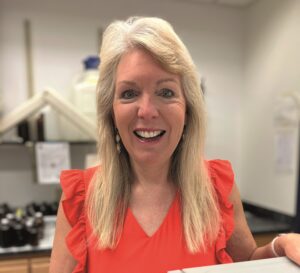
Professor Susan Richardson, from the University of South Carolina, USA, gave a keynote at IWA’s 13th Micropol and Ecohazard Conference, held in Taipei, Chinese Taipei, on 16-20 June. Here she highlights recent advances in identifying important drivers of toxicity and the need to address new impacts on water quality.
Disinfection by-products (DBPs) are an unintended consequence of drinking water disinfection and are formed by the reaction of natural or anthropogenic organic matter, bromide, and iodide with disinfectants, such as chlorine, chloramine, ozone, or chlorine dioxide. DBPs are different from other environmental contaminants because they are not created for any particular purpose and are not released into rivers from industries, but are formed during drinking water treatment, which can make them harder to identify.
More than 700 DBPs have now been identified in drinking water, but only a very few are regulated. For example, only 11 are currently regulated in the USA. In addition, contaminants such as per- and polyfluorinated alkyl substances (PFAS), also known as ‘forever chemicals’, may or may not be in your drinking water. In contrast, DBPs are always in disinfected water, generally at 1000x higher levels than PFAS and other traditional contaminants.
“More than 700 DBPs have now been identified in drinking water, but only a very few are regulated”
Moreover, there are documented adverse health impacts of DBPs (including bladder cancer, miscarriage, and birth defects) that are not yet completely controlled. In addition, there are many more DBPs waiting to be identified, as around 70% of the halogenated DBPs in chlorinated drinking water are still not accounted for. Therefore, it is important to understand what these chemicals are that we are drinking every day in our water.
Additional impacts
While DBPs can form from the disinfection of pristine (uncontaminated) waters, there are also new impacts on our water supplies. These include fracking, coal-fired power plants, and algae.
Fracking wastewater can release high levels of bromide and iodide, forming the more toxic bromine- and iodine-containing DBPs. Coal-fired power plants that switch to a wet flue gas desulfurisation process (that reduces the amount of mercury released to the air) also release high amounts of bromide and iodide that can impact downstream drinking water plants.
In addition, harmful algal blooms are increasing throughout the world and, along with releasing harmful toxins to drinking water sources, the algal organic matter can also double the formation of DBPs if it enters drinking water treatment (e.g., when water is pre-disinfected in a reservoir for algae control).
Climate change and increasing droughts are also leading water utilities to other water sources, including seawater and wastewater. Wastewater is the cheaper of these alternatives and is always present wherever humans are present, making it a readily available source. The western states in the USA are now moving in this direction of potable reuse, where wastewater is turned into drinking water. This process generally uses microfiltration or ultrafiltration membranes, followed by reverse osmosis membrane filtration and advanced oxidation, which is then treated further (typically chlorinated) for final drinking water treatment.
Wastewater as a source of contaminants
One of my new studies on potable reuse included a look at priority contaminants not well removed in wastewater treatment that could be further transformed in potable reuse treatment. These priority contaminants included hormones (17β-estradiol, estrone, 17α-ethinylestradiol), an endocrine disruptor (bisphenol A), a pharmaceutical (diclofenac), an antimicrobial (triclosan), and a surfactant breakdown product (nonylphenol). The impact of chlorine on these contaminants spiked into ultrapure water and spiked into real samples from different treatment stages of an advanced reuse plant was investigated using a nontarget approach with liquid chromatography (LC) and gas chromatography (GC) -high resolution-mass spectrometry (MS). Many DBPs were identified, including 28 not previously reported. Toxicity measurements revealed that some compounds became more toxic following treatment with chlorine. On the other hand, many compounds became less oestrogenic after treatment; however, the presence of bromide could change this.
New halocyclopentadiene DBPs were the focus of another new discovery by my group, where GC-high resolution-MS was used for their identification. This new class of DBPs is the first expected to be bioaccumulative, and one of these (hexachlorocyclopentadiene) is now the most cytotoxic DBP studied to date. This discovery was completely by accident, made by a student who was including drinking water samples as a control for DBPs formed while brewing tea. The student saw new mass spectra with extensive chlorine and bromine isotopic patterns that were not present in the library databases.
My ‘secret sauce’ for finding unknown contaminants in water involves extracting large volumes of water with XAD resin columns (to achieve high concentration factors), a highly sensitive mass spectrometer, and ‘old fashioned’ manual interpretation of mass spectra. Obtaining the accurate masses using high resolution-MS, examining isotopic patterns and fragmentation patterns, considering all possible isomers, and confirmation with authentic standards were important.
A further recent ‘forcing factors’ study involved detailed investigation of the main drivers of toxicity in water. This work involved quantification of 72 regulated and priority DBPs and measurement of whole water cytotoxicity. Drinking water from across the USA was investigated, including seawater and wastewater-impacted waters. Significant correlations of cytotoxicity with nitrogenous and iodinated DBPs were found. Results revealed that unregulated haloacetonitriles and iodoacetic acids were important toxicity drivers of cytotoxicity and should be considered for regulation.
The good news is that there are methods that can be used to reduce DBP levels in drinking water, including granular activated carbon (GAC) pretreatment with a small dose of chlorine or the use of ozone, along with the use of ion exchange resins to reduce brominated and iodinated DBPs.
Given all of the above, my message is: “We have good water, but we can do better.” •
Further reading
Potable reuse study: Cochran, KH, et al., 2023. ‘Chlorination of Emerging Contaminants for Application in Potable Wastewater Reuse: Disinfection By-Product Formation, Estrogen Activity, and Cytotoxicity’. Environ. Sci. Technol., 58: 704–716. pubs.acs.org/doi/10.1021/acs.est.3c05978
New halocyclopentadiene DBPs study: Li, J, MT Aziz, CO Granger, and SD Richardson. 2022. ‘Halocyclopentadienes: An Emerging Class of Toxic DBPs in Chlor(am)inated Drinking Water’. Environ. Sci. Technol., 56: 11387–11397. pubs.acs.org/doi/10.1021/acs.est.2c02490
Forcing factors study: Allen, JM, et al, 2021. ‘Disinfection By-Product Drivers of Cytotoxicity in U.S. Drinking Water: Should Other DBPs Be Considered for Regulation?’ Environ. Sci. Technol., 56: 392−402. pubs.acs.org/doi/10.1021/acs.est.1c07998
The author: Dr Susan D Richardson is the Arthur Sease Williams Professor of Chemistry at the University of South Carolina and was formerly at the US EPA for many years. Her research surrounds the study of emerging contaminants in water. She is a member of the US National Academy of Engineering (2024), Executive Editor and Associate Editor for Environmental Science & Technology, past President of the American Society for Mass Spectrometry (2020-2022), and received the American Chemical Society Award for Creative Advancements in Environmental Science & Technology (2008).
The post Drinking water safety: Addressing new impacts and toxicity drivers appeared first on The Source.
]]>The post Net zero – desalination’s transition story appeared first on The Source.
]]>Freshwater scarcity – one of the biggest challenges of our time – continues to expand across different regions. This issue is escalated further by the continuous growth of population in inherently water stressed regions.
The Middle East is one of the most arid regions in the world, with a high risk of freshwater stress in the coming decades. Given the region’s abundant access to seawater, a reliance on desalination technologies has become critical to fulfilling the freshwater needs of its population and economy. Of these desalination technologies, the most widely used is membrane-based seawater reverse osmosis (SWRO), as it is considered one of the most efficient methods of desalination and has a low footprint.
Based on the separation of water and inorganic salt solute from seawater through a semi-permeable membrane, SWRO uses energy to counter the osmotic gradient of seawater to produce low salinity permeate and concentrated brine. Because of rapid industrial and population growth, reliance on SWRO is increasing. As a result, the optimisation of existing SWRO plants, along with the design of new, efficient plants, is of critical importance.
The SWRO process has undergone several enhancements over the past decade, but it remains an energy and chemically intensive process that intensifies environmental stress. To address this, ACWA Power has pioneered a paradigm shift in the design of large-scale desalination plants by making energy needs central to all its design work and by applying a new design approach to desalination plants based on knowledge from its other core businesses.
“R&D is aimed at optimising efficiency to produce desalinated water, reliably and responsibly, at low cost”
In the past decade alone, we’ve reduced energy consumption from 22 kWh per cubic metre to less than three – almost a 90% cut in power used by our plants. That is not only good for our bottom line, but also for the planet.
ACWA Power has been a champion of the reduction of specific energy consumption (SEC) from the reverse osmosis of seawater. Technological innovation has been part of our DNA from the beginning, and it continues to be integral to the way we operate, and key to our success. Our R&D is aimed at optimising efficiency to produce desalinated water, reliably and responsibly, at low cost.
The pressing demand to squeeze energy consumption to its near theoretical level has prompted research primarily focusing on improving the energy efficiency of the process. The use of novel materials to develop next generation desalination membranes with ultra high water permeability and high water–solute selectivity has been explored thoroughly. Yet, despite substantial research efforts towards the development of highly efficient membranes, the resulting reduction in energy consumption has been minimal. This calls for a paradigm shift in the current approach to desalination research towards rational system design, as well as the optimisation of process operations.
Pretreatment efficiencies
For a SWRO plant to operate to its full, long-term potential and consistently produce optimal water quality, it is critical to have an effective pretreatment system. Effective pretreatment increases the quality of the feed seawater to the RO membranes by minimising its fouling potential, thereby minimising damage to the RO membrane downstream, maximising the lifetime of the RO membrane and reducing energy consumption.
Biofouling prevention
Biofouling is a pervasive problem in the SWRO process. We are working on several fronts to tackle this, including testing of newer pretreatment technologies, such as ceramic and graphene-based ultrafiltration membranes, testing advanced filtration media, and even developing newer methods to test water quality that are more robust than the current status quo.
The accumulation of unwanted material on the membrane surface, collectively called fouling, is key to the improvement of RO desalination. Fouling includes deposition of inorganic minerals, accumulation of particulate matter, and biofouling, which refers to biofilm formation resulting from deposition of organic matter and microbial deposition and growth. Layers of fouling and biofouling of a few micrometres thick are enough to induce increased energy requirements for water production, decreased membrane efficiency, and early membrane failure.
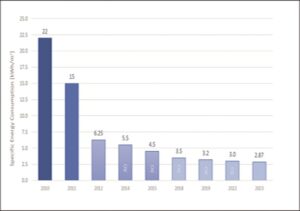
the seawater desalination process
Reducing scaling
The deposition of inorganic minerals or scaling occurs when the concentration of rejected salts along the RO membrane exceeds its solubility limit. To mitigate scaling problems, the addition of antiscalants during pretreatment of the feed water is the most
cost-effective and convenient method. Antiscalants are chemicals that inhibit the formation of minerals through chelation, dispersion, and/or by blocking crystal growth sites.
Although antiscalants mitigate inorganic fouling, they can increase the potential of biofouling, which is regarded as the most difficult fouling problem to deal with. Depending on their chemical components, antiscalants can function as phosphorus and/or carbon sources for microbial growth.
Together with our partners at King Abdullah University of Science and Technology (KAUST), Saudi Arabia, we have developed a method that allows for a rational selection of antiscalants based on assessing their bacterial growth potential and chemical structure using nuclear magnetic resonance (NMR) spectroscopy.
Working smarter
The industry also requires better quality and new types of sensors to enable more data to be derived from plants, and tools to be developed to use this data in a smart way. We are looking at advances in artificial intelligence (AI) to improve sensing technology within a package that allows us to move to predictive analytics. This is very much in line with the direction of our general research portfolio, enabling us to develop a holistic approach for a monitoring system that uses the latest technology to help us further optimise plant performance.
We have developed a model to use an artificial neural network-based algorithm to optimise the chemical consumption of coagulants. This is used to predict the Silt Density Index (SDI) of filtered seawater based on the coagulant dosing rate. The developed algorithm resulted in the reduction of coagulant consumption by 11.7%, reducing the operational cost of the desalination plant.
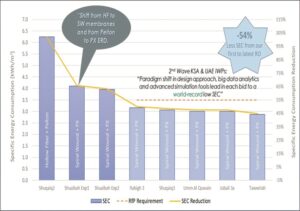
seawater reverse osmosis process
Automated performance tracking
We used desalination plant operational data to develop an automated membrane performance tracking and diagnostics system. This system is established with data pipelines from more than 20 seawater desalination plants, with a total production capacity more than 5 Mm3/d. The system can provide valuable insights to the operators by supplying important information such as forecasting the timeline for the next cleaning in place (CIP), and detection of the root cause of membrane performance decline. These insights enable preventative and corrective actions to be taken to optimise the SWRO plant’s day-to-day operations and further reduce operational costs.
“we’ve reduced energy consumption from 22 kWh per cubic metre to less than three”
Performance model
A SWRO system consists of different components, such as pumps, membranes, valves, and energy recovery devices, and while it is simple for process designers to understand the performance of these components individually, the performance of an entire SWRO system can be complex and counterintuitive.
We have developed a performance model for reverse osmosis (PMRO) that is capable of monitoring, optimising, and designing an entire SWRO system, starting from the seawater intake through to the post-treatment stage, while meeting final water quality requirements.
PMRO has the capability of predicting plant performance in real time and finding the best efficiency operating points to minimise SEC and reduce operational costs. This is the first programme in the public domain to treat an SWRO process as a complete, coupled system, and aims to meet the needs of all involved in the optimisation process of a SWRO plant.
Software alone, however, won’t be enough. We need a concerted effort to change the way we monitor and measure, combined with smarter tools and the utilisation of collective intelligence – a mix of artificial and human intelligence – to bring about the efficiencies the sector needs.
Disruptive desalination
We’ve recently partnered with a start-up in Europe to develop a new disruptive desalination technology. This will bring together many of the benefits that are now being demanded of the industry and is expected to desalinate 42,000 ppm of seawater at a total plant SEC equal to or less than 2.2 kWh/m3. Additionally, it does not require any chemical additives and produces a brine with salinity much lower than in a typical desalination plant. Essentially, the aim is to produce non-toxic, clean, low-salinity brine to be discharged to the sea, with energy consumption reduced again by a third, so reducing our carbon footprint by a further 30%.
In a nutshell, through innovation we continue to accelerate the transition towards zero emission desalination, aimed at delivering the cleanest, most affordable, and energy-efficient freshwater. •
Acknowledgements:
The author would like to extend his profound appreciation to Thomas Altmann, EVP – Innovation and New Technology, the entire innovation team at ACWA Power, and collaborators from King Abdullah University of Science and Technology, Saudi Arabia.
The author: Dr Ratul Das is Executive Manager, Research and Development, at ACWA Power.
The post Net zero – desalination’s transition story appeared first on The Source.
]]>The post Urban Tehran embraces the Water Sensitive City concept appeared first on The Source.
]]>Tehran, the capital of Iran – with a population of 11 million – experienced water stress between 2020 and 2023. The amount of rainfall in Tehran province in the year 2022–23 reached 194.4 mm, which was 80 mm less than the long-term average. Consequently, the usual approaches to urban water management were not equipped to provide sustainable water services to the city’s citizens. As a result, a relatively new concept that was initiated in 2004 as part of Australia’s National Water Plan – Water Sensitive Cities (WSC) – has been designed and implemented for the city. WSC provides an ecological solution to achieve sustainability in urban environments with a focus on water.
Water Sensitive City plan
The integrated management of water resources deals with two approaches: supply management and demand management. Any type of activity aimed at producing, extracting and distributing water in the best and most economical way is called supply management, and any type of economic, social, technical, or other policy that optimises demand is called demand management. In demand management, the reduction of consumption, recycling and reuse of water, the reduction of non-revenue water, the implementation of a circular economy, and the optimal use of wastewater are the primary axes of a WSC. Moreover, WSCs are particularly adaptable to climate change impacts such as floods and drought.
The approach in Tehran
Adopting a holistic approach and working with policymakers and NGOs, Tehran’s WSC plan encompasses three programmes – ‘social’, ‘relational’, and ‘operational/practical’. The social programme focuses on societal education, dialogue, and facilitation; while the operational programme encourages the optimal management of water consumption, utilises social marketing, and disseminates information about this innovation.
Implementation of the WSC plan depends on the social campaign, which performs two actions to manage the demand. First, it aims to inform and change the behaviour of the public and policymakers. Second, it aims to encourage trans-sectoral cooperation.
The social programme is led by the Public Affairs Office of Tehran Province Water and Wastewater Company (TPWW Co) under the title of the ‘Tehran Water Sensitive City’ Campaign. This is the initiating component of the WSC, while the promotion of the WSC takes a coordinated multi-organisational approach. According to the director of the Sustainable Development Office of TPWW Co, the launch of this campaign is a step towards a scientific and applicable approach to urban water management, as well as a social campaign to influence the culture around water.
The future of the WSC plan
The WSC campaign has launched, and the communication and operational plans are moving forward. In combination with Tehran’s monitoring and data processing plan for the city’s water and wastewater facilities, the WSC plan is to be upgraded to a water-wise city plan – a framework that will help the city’s leaders develop sustainable water systems and resilient urban planning. •
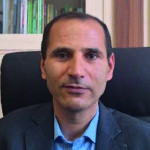

The authors: Seyedhossein Sajadifar is director of the Sustainable Development Office of the Tehran Province Water and Wastewater Company, and Pezhman Taherei is secretary of the IWA Public and Customer Communications Specialist Group and executive secretary of the Young Water Professionals Iran Chapter
The post Urban Tehran embraces the Water Sensitive City concept appeared first on The Source.
]]>The post Celebrating the global best in water project innovation appeared first on The Source.
]]>IWA’s Project Innovation Awards (PIA) were launched in 2006 to recognise that shared and pressing challenges can be overcome through the development and implementation of creative water solutions. Recognising and championing water innovators, these awards are dedicated to fostering sustainable utility operations, safeguarding community health and safety, and shaping our global water future. By celebrating innovation and spotlighting its creators, the IWA Project Innovation Awards proudly acknowledge those who have taken on the challenge of providing a sustainable water future for all.
Competition and judging
The 14th edition of the PIAs had an impressive 108 entries from 34 countries during the nomination process, starting from early 2024. This level of engagement highlights the extensive innovation and ambition within the IWA network, offering great optimism for the sector.
Entries were well distributed across the six award categories, each representing a unique area of innovation in water management. An independent panel of expert judges evaluated each project based on its innovative qualities and key outcomes, also considering the circumstances of its development and its potential for broader impact. After a thorough and competitive evaluation process, the panel selected the top three projects in each category, with these placed as Gold, Silver and Bronze.
Grand Innovation Award
The expert panel selected the Grand Innovation Award winner from the six Gold medallists from each of the PIA categories to represent the pinnacle of excellence in water sector innovation.
The IWA Grand Innovation Award 2024 embodies a vision of a future where water, a fundamental human right, is managed wisely to balance human and ecological needs sustainably. Highlighting the importance of innovative solutions, this award honours groundbreaking achievements in the global water industry.
The project selected as the Grand Innovation Award winner for 2024 was ‘Inspiring Technological and Market Transformation: Practice of the China Concept Wastewater Resource Facility’, by the Committee of China Concept Wastewater Treatment Plant and CSD Water Service Co., Ltd., China.
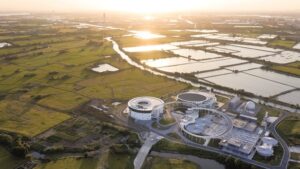
This project, the Gold winner in the Market-changing Water Technology and Infrastructure category, has forged a new concept in wastewater treatment that boosts local water resilience, supports agriculture with nutrient-rich soil, and serves as a model for sustainable wastewater management globally, inspiring further initiatives and international collaboration. It stems from the move by several distinguished professors specialising in wastewater treatment, led by Professor Jiuhui Qu, to form the China Concept WWTP Committee (CCWC) in 2014.
Market-changing Water Technology and Infrastructure
GOLD: Inspiring Technological and Market Transformation: Practice of the China Concept Wastewater Resource Facility, by the Committee of China Concept Wastewater Treatment Plant, CSD Water Service Co., Ltd., China
With the need to increase the capacity of China’s wastewater treatment facilities, thousands of new wastewater treatment plants (WWTPs) are required in the country. In response to this – and concerned that new WWTPs are equipped to tackle the challenges of climate change, resource scarcity and sustainability – several distinguished professors specialising in wastewater treatment, led by Professor Jiuhui Qu, formed the China Concept WWTP Committee (CCWC) in 2014.
The CCWC aims to build approximately 100 Concept Plants, applying advanced technologies and covering various local conditions, different capacities, distinctive features, and diverse models. These will promote substantial changes and upgrades in industry construction forms, technology and standards.
One such Concept Plant, the Yixing Concept Water Resource Reclamation Facility (WRRF), a $42m project, began operations in October 2021. It handles 20,000 m3 of wastewater and processes 100 tonnes of organic matter daily. Key objectives include surpassing environmental standards, achieving energy self-sufficiency through bioenergy, and enhancing resource recovery.
SILVER: The Linear Path to Circularity! by A´guas do Tejo Atlantico, Portugal
A plan to transform linear wastewater treatment plants into ‘Water Factories’, this project aims for water circularity by 2025, focusing on increasing quality water reuse.
BRONZE: South African Sanitation Technology Enterprise Programme (SASTEP), by the Water Research Commission, South Africa
SASTEP fosters innovation in sanitation technology, bridging the gap between research, development and commercialisation, and promoting new sanitation solutions.
Breakthroughs in Research and Development
GOLD: Redefining Wastewater Treatment Technology – Design, Construction and Operation of the World’s First Mainstream Partial Nitritation-Anammox Wastewater Treatment Facility, by Beijing Drainage Group Co., Ltd., Beijing University of Technology, China
This project has developed the world’s first successfully implemented mainstream deammonification process for treating wastewater. The PNAAF (Partial Nitritation Activated Sludge coupled with Anammox Fixed-film) process, jointly developed by the Beijing Drainage Group and Beijing University of Technology, China, was pilot tested and subsequently designed, constructed and operated at Beijing’s Fangzhuang Wastewater Treatment Plant (7200 m3/d).

Wastewater Treatment Facility
SILVER: Integration of TADOX Technology to achieve Net Zero in Textile Wastewater Treatment, by The Energy and Resources Institute (TERI), India
Using TERI Advanced Oxidation Technology (TADOX), invented by Dr Nupur Bahadur, this innovative process involves UV-TiO2 photocatalysis for the removal of colour and dissolved organics from textile wastewater.

BRONZE: IntensiCarb, All in One Process, by Brown and Caldwell, Trojan Technologies, US Peroxide Technologies, USA
This innovative anaerobic digestion intensification technology combines vacuum evaporation with fermentation or anaerobic digestion.
Governance, Institutions and Social Enterprise
GOLD: Wollert Community Farm, by Yarra Valley Water, Australia
Developed in collaboration with Whittlesea Community Connections and Melbourne Polytechnic, this community farm in Melbourne’s northern suburbs utilises buffer land at a recycled water treatment plant, with the aim of enhancing biodiversity, promoting local food security, and fostering community engagement through regenerative farming and education initiatives.

SILVER: Tetra Safe Drinking Water Project: Leveraging Solar Energy to Support Lower Income Communities in Bangladesh’s Coastal Region, by Tetra Private Limited, Bangladesh
By developing a solar-powered desalination device to provide 1000 litres of purified water daily, at a low cost, this project is already delivering access to safe water to 1200 households.

BRONZE: Jaldoot Programme, by Public Health Engineering Department and Jal Jeevan Mission, Assam, India
This initiative trains students through workshops focusing on water, sanitation, and hygiene (WASH) and the functionality of piped water supply schemes.
Performance Improvement and Operational Solutions
GOLD: Government-led City-wide COVID-19 Sewage Surveillance in Hong Kong with Engineering and Smart Technology Applications, by the Environmental Protection Department, Hong Kong SAR Government, China
Utilising engineering and smart technology applications, this project implemented a unique and dynamic city-wide sewage network-based surveillance programme, facilitating real time decision-making for controlling COVID-19 transmission across the city with coverage of more than 80% of the city’s population.
SILVER: Whole Life Cycle Management System of Municipal Pipe Networks in Developing Areas by the Three Gorges Smart Water Technology Company Ltd., and the Shanghai Investigation, Design & Research Institute, China
This digital management system for municipal sewer networks, focuses on small- and medium-sized cities along the Yangtze River, which supports 33% of the country’s population.
BRONZE: All-factor Collaborative Digital Governance Demonstration for Pollution and Waterlogging of the Shenzhen River Basin, by Shenzhen Water and Environment Group Co., Ltd., China
This project focuses on the optimisation of water management in mega cities, adopting collaborative digital governance of all factors resulting in pollution and waterlogging.
Exceptional Project Execution and Delivery
GOLD: Ontario Wastewater Surveillance Initiative (Ontario WSI), by the Ministry of the Environment, Conservation and Parks (MECP), Canada
Initiated in 2020 to monitor the spread of COVID-19 – leveraging GIS, IoT, big data, and machine learning, to provide real time, actionable data, using wastewater analysis – the scope of the surveillance has now extended to influenza, RSV, and other pathogens.
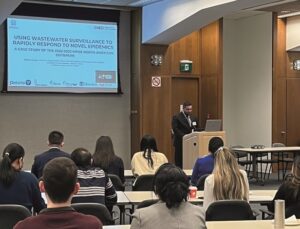
SILVER: Huangxiao River and Airport River Water Environment Comprehensive Treatment PPP Project, Green Industry Investment Ltd. from the 3rd Bureau of China State Construction Engineering Co. Ltd.; (CSCEC), Wuhan Municipal Water Authority; 3rd Bureau of CSCEC.
Enhancing water quality and flood control, this project was the first in Hubei to be selected in the Global Infrastructure Hub (GIH) project database.
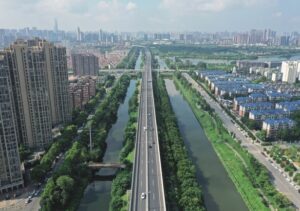
BRONZE: 120 MLD SWTP 9 Stage 6 Phase 1, Jubail, Kingdom of Saudi Arabia, by VA Tech Wabag Ltd., India
This groundbreaking wastewater treatment plant, alongside its extensive treatment scheme, incorporates a state-of-the-art 20 mld tanker pumping station and cutting-edge sludge treatment systems.
Smart Systems and the Digital Water Economy
GOLD: Digital Twin Platform for Water Distribution System in Fuzhou, by Fuzhou Water Group Co., Ltd., China
This platform constructed a GIS system to realise digital archiving of 4500 km of the pipeline network and 194,000 ancillary facilities, deploying 804 monitoring sensors in the municipal network, feeding information to a water big data centre.
SILVER: Digital Dosing for Sustainable Sewer Protection, by the University of Queensland, Australia
This real time control system utilises digital twins, advanced optimisation algorithms, cloud computing, and IoT networks to dynamically and automatically manage chemical dosing according to real needs.

BRONZE: The AI-Acoustic Underground Leak Detection System: A Case Study of Taiwan Water Corporation, by Taiwan Water Corporation (TWC), Industrial Technology Research Institute (ITRI), Chinese Taipei
This advanced Smart Acoustic Identification System for diagnosing leaks in piping systems integrates AI and IoT technologies to accurately identify leak locations. •
For more details on the winning projects, visit: iwa-network.org/press/global-best-in-water-projects-announced-at-iwa-2024-project-innovation-awards
The post Celebrating the global best in water project innovation appeared first on The Source.
]]>